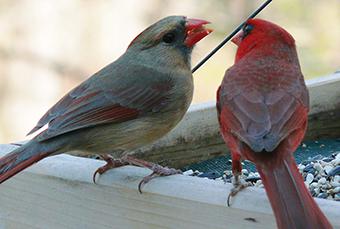
The Passionate Gardener: Spotting Cardinals Never Gets Old
September gardening reminders
- Lawn care: Labor Day is the best time for fall lawn fertilizer (no additional fertilizer is needed until Thanksgiving). Sow grass seed, apply corn gluten meal for organic lawn treatment if you are not planting grass seed.
- Continue to harvest veggies; sow cover crops; sow seeds for fall greens; keep winter squash on vines until skin is hard — resists pressure from your thumbnail — and the rind is not shiny; continue to cut kale and chard outer leaves regularly until frost.
- Bring houseplants back indoors.
- Deadhead roses, annuals and perennials for potential new blooms. Note: These plants will not rebloom: astilbe, monarda, dianthus, lilies, iris, phlox and tall sedum.
- Start planting spring bulbs.
We’ve been in our house for 12 years and my wife still shrieks with delight every time she sees the bright red feathers of a male cardinal in the trees or at our feeder. Everyone loves cardinals. Seven states (Illinois, Indiana, Kentucky, North Carolina, Ohio, Virginia and West Virginia) have declared it their state bird.
Northern cardinals (Cardinalis cardinalis) are found mainly in the eastern United States from southern Canada all the way through Texas to Mexico and Guatemala.
Cardinals do not migrate. Cardinal “couples” often mate for life, although they may stay together at breeding and nesting times only. They generally appear at feeders in either early morning or evening when their colors don’t stand out so much and hawks can’t pick them out easily. (The male cardinal is the only all-red crested bird.)
These birds can withstand intense winter cold. Somehow, they increase their metabolic rate while reducing their water loss.
Cardinal courtship displays can occur as early as late January in even the coldest climates. As mating progresses, males feed the females. They work together in selecting a nesting site. They also rarely fight with one another. However, during the breeding season, males will chase other males and females will chase other females away from their nesting area. They raise at least two, sometimes three, broods a season starting in the spring. There are still many questions as to why some cardinals stay together and others do not, although if a mate dies, it is pretty certain that the other will find another mate.
Territorial fighting stops by late summer and in the fall, cardinal flocks start forming. These flocks vary according to weather, habitat, time of day and time of year, but they usually are made up of roughly equal numbers of males and females.
Cardinals, along with many other resident birds, have to contend with harsh winter weather conditions, predators and disease. Predators include snakes, crows, blue jays, cowbirds, owls and hawks, plus squirrels and chipmunks that eat their eggs — and cats. Their life span could be 15- 20 years but most don’t make it that long.
Cardinal nests are normally well hidden in the dense foliage of shrubs, trees and often, out-of-control vines such as wild grape or honeysuckle. The nests are built by the females without much assistance from their mate and are rarely higher than 10 feet off the ground. Cowbirds can be a problem as they often lay their own eggs in cardinal nests.
Once the cardinal eggs hatch, the babies stay in the nest for about 10 days with both parents feeding them constantly with insects, spiders and other small invertebrates. The young can leave their nest but they generally don’t fly for at least another week and it could take over a month before they are actually on their own. Then the female gets to work on her next brood, building an entirely new nest.
If you are trying to attract cardinals with a feeder, make sure they have a platform with a place to stand. They can’t hang upside down like other small birds. Also, make sure you supply clean water for drinking and bathing. A bird bath is fine but keep it clean. Adult cardinals will eat seeds, berries and flower buds along with insects; their favorite is black-oil sunflower seed. They also eat safflower seed, millet, cracked corn and small fruits, so most conventional packaged birdseed will suit them.
For questions or comments: ron@primexgardencenter.com

